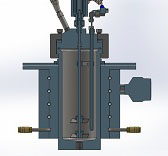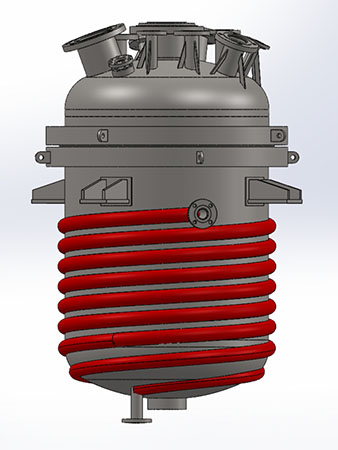
24 Jul 2023
Oftentimes, we notice customers struggle to specify the best heating and cooling options when ordering reactors. We thought it may be useful to review some of the options and share our experience about which option works best in what scenarios.
Let’s start with the reactions which are endothermic and require a heating ability. Although plants will typically use steam or a heating fluid for this application, but at lab scale an external electric heating mantle is often a go-to option. Being safe, efficient and relatively low cost this is often a customer favorite. The advantage of the external electric mantle is that it does not require any additional utility such as oil/water and it can be provided with flameproof design as well. Remember to specify the right hazardous area classification, such as ATEX or Ex-proof IIA/IIB in situations where solvents, explosive gases etc. are involved.

Reactor with External Heating Electric Heating Mantle
(Available for reactors from 100ml to 100L volume)
In many situations a reaction needs both cooling and heating abilities. Sometimes, this can be for two different reaction steps, one which needs heating and another cooling. At other times, it can be for the same reaction which must first require the mixture to be heated to (say 180 Deg.C) and then the reaction kicks off at which point the exotherm requires cooling to maintain isothermal conditions. In such cases, the default configuration can be an external electric heating mantle along with an internal cooling coil.

Reactor with External Heating Mantle and Internal Cooling Coil
(Available for reactors from 100ml to 100L volume)
We should also point to a more unique configuration that customers are rarely aware of: This is an external aluminum cast heater with embedded cooling coil in it. This is a rather unique configuration but some customers love it in situations where their fluids are slurries etc which will preclude the use of internal coils. In general, this is not a recommended configuration due to the possibility of hard to find leaks etc. and is only used when no other better option fits the task.

Reactor with External Aluminum Cast Heater with Embedded Cooling Coil
(Available for reactors from 100ml to 25L volume)
Now, consider the simplest system: an external jacketed reactor. This is often the most robust configurations for applications which are not very demanding in terms of exothermicity. Fabrication costs are lower and probability of leaks very low. Especially for applications where intermixing of process fluid with cooling / heating media can be dangerous in case of leaks this is the preferred configuration. Remember, even for applications where the reactor uses an exotic MOC e.g. Hastealloy-C, the jacket can still be designed from a cheaper MOC like SS304.

Stirred reactor with an external jacket
(Available for reactors of all capacities)
Visit Stirred Pressure Autoclave Reactors to know more about these reactors.
On the downside, in the jacketed configuration heat transfer coefficients can be low (stay tuned for a next blog post in this series where we give some correlations and online tools to calculate this HTC) and especially if the application is high pressure then the thick walls of the reactor can impede heat transfer. An arrangement that is feasible for large reactors are external limpet coils. These provide a better heat transfer coefficient than a jacket and typically higher flow velocities and resistance to fouling.

Reactor with external limpet coils
(Available for reactors from 100L & above capacities)
In some situations, customers may prefer twin external limpets where you have the option of using two different utilities.

Reactor with twin limpet coils
(Available for reactors from 100L & above capacities)
Stay tuned for more ideas on heating and cooling configurations in our next blog post (Part 2 on this topic)
Also, visit Plant Scale Pressure Reactor to know more about Large Reactors.
Send us your requirements on info@amarequip.com